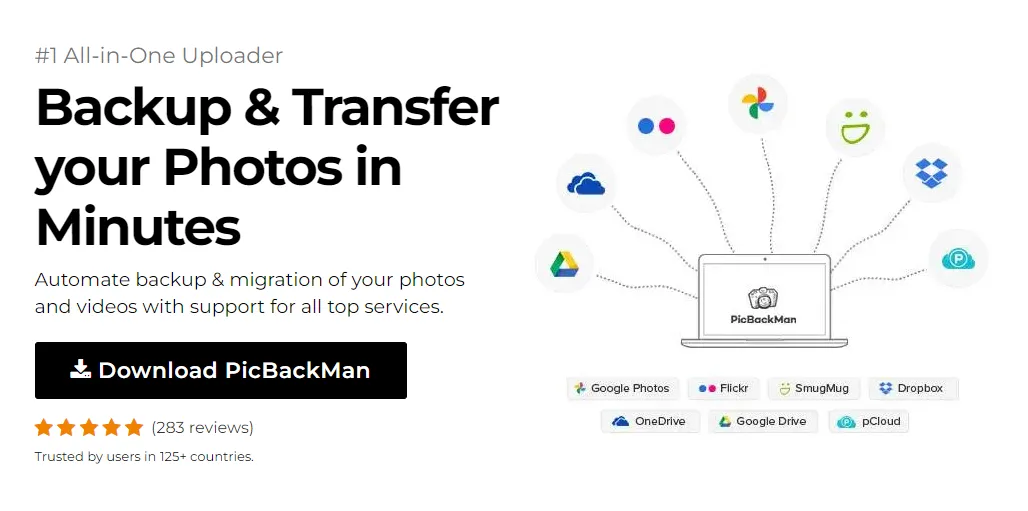![Fix OneDrive Not Syncing with SharePoint Issues [Full Guide]](https://www.picbackman.com/images/tips-tricks-img/fix-onedrive-not-syncing-with-sharepoint-issues.webp)
Why is it the #1 bulk uploader?
- Insanely fast!
- Maintains folder structure.
- 100% automated upload.
- Supports RAW files.
- Privacy default.
How can you get started?
Download PicBackMan and start free, then upgrade to annual or lifetime plan as per your needs. Join 100,000+ users who trust PicBackMan for keeping their precious memories safe in multiple online accounts.
“Your pictures are scattered. PicBackMan helps you bring order to your digital memories.”
Fix OneDrive Not Syncing with SharePoint Issues [Full Guide]

![Fix OneDrive Not Syncing with SharePoint Issues [Full Guide]](https://www.picbackman.com/images/tips-tricks-img/fix-onedrive-not-syncing-with-sharepoint-issues.webp)
Having trouble with OneDrive not syncing with SharePoint? You're not alone. This common issue can disrupt your workflow and make collaboration difficult. The good news is that most sync problems have straightforward solutions. In this comprehensive guide, I'll walk you through all the possible fixes for OneDrive and SharePoint sync issues, from basic troubleshooting to advanced solutions.
Common Causes of OneDrive-SharePoint Sync Problems
Before diving into solutions, let's understand why these sync issues happen in the first place:
- Network connectivity problems
- Outdated OneDrive client
- File path or name restrictions
- Insufficient permissions
- Storage limitations
- Conflicting sync relationships
- Corrupt cache files
- Large file synchronization issues
Quick Fixes for OneDrive Not Syncing with SharePoint
Let's start with some quick solutions that often resolve sync issues:
1. Check Your Internet Connection
A stable internet connection is essential for synchronization between OneDrive and SharePoint. Try these steps:
- Connect to a different network if possible
- Restart your router
- Run the Windows Network Troubleshooter
- Check if other online services are working properly
2. Verify OneDrive is Running
Sometimes the OneDrive app might not be running in the background:
- Look for the OneDrive cloud icon in your system tray
- If it's not there, search for "OneDrive" in your Start menu and launch it
- Check if the sync process starts automatically
3. Restart OneDrive
A simple restart can fix many sync issues:
- Right-click the OneDrive icon in your system tray
- Click "Close OneDrive"
- Open OneDrive again from your Start menu
- Check if synchronization resumes
Step-by-Step Solutions for OneDrive-SharePoint Sync Issues
If the quick fixes didn't work, let's try more thorough solutions:
Solution 1: Update OneDrive to the Latest Version
Outdated OneDrive clients often cause sync problems with SharePoint:
- Right-click the OneDrive icon in your system tray
- Click on "Help & Settings" then "Settings"
- Go to the "About" tab
- Click "Check for updates"
- If updates are available, install them and restart OneDrive
For manual updates:
- Download the latest OneDrive client from Microsoft's website
- Close the current OneDrive app
- Run the installer and follow the prompts
- Sign in with your account credentials
Solution 2: Reset OneDrive Sync
Resetting the sync relationship can solve persistent issues:
- Press Win + R to open the Run dialog
- Type
%localappdata%MicrosoftOneDriveonedrive.exe /resetand press Enter - Wait for the OneDrive icon to disappear from your system tray
- Open OneDrive again from the Start menu
- Sign in and set up your sync preferences again
Solution 3: Clear OneDrive Cache
Corrupt cache files can interfere with proper synchronization:
- Close OneDrive completely
- Press Win + R to open the Run dialog
- Type
%localappdata%MicrosoftOneDrivesettingsand press Enter - Delete all files in this folder (don't delete the folder itself)
- Restart OneDrive and check if syncing works properly
Solution 4: Check File Path and Name Limitations
SharePoint and OneDrive have specific limitations for file names and paths:
| Restriction Type | Limitation |
|---|---|
| File path length | Maximum 400 characters (including the URL) |
| File name length | Maximum 255 characters |
| Invalid characters | " * : ? / | |
| Invalid file names | .lock, CON, PRN, AUX, NUL, etc. |
To fix this issue:
- Check the OneDrive sync status to identify problematic files
- Rename any files that violate these restrictions
- Move files to reduce path length if necessary
- Restart the sync process
Solution 5: Check SharePoint Permissions
Insufficient permissions can prevent proper synchronization:
- Go to the SharePoint site in your web browser
- Click on the gear icon (Settings) in the top right
- Select "Site permissions"
- Verify you have at least "Edit" permissions
- If not, contact your SharePoint administrator to request appropriate access
Solution 6: Verify Storage Space
Insufficient storage can halt synchronization:
- Check your OneDrive storage usage by right-clicking the OneDrive icon
- Select "Help & Settings" then "Settings"
- Go to the "Account" tab to see your storage usage
- Free up space if you're near your limit
- Check your local disk space as well
Solution 7: Use the OneDrive Troubleshooter
Microsoft offers a dedicated troubleshooting tool:
- Download the OneDrive Troubleshooter from Microsoft's website
- Close OneDrive completely
- Run the troubleshooter
- Follow the on-screen instructions
- Apply any recommended fixes
- Restart OneDrive and check if syncing works
Advanced Solutions for Persistent Sync Issues
If you're still experiencing problems, try these more advanced fixes:
Solution 8: Recreate the Sync Connection
Sometimes starting fresh is the best approach:
- Right-click the OneDrive icon in the system tray
- Go to "Help & Settings" then "Settings"
- Select the "Account" tab
- Click "Unlink this PC"
- Restart your computer
- Set up OneDrive again and reconfigure your sync settings
- Go to your SharePoint site and click "Sync" to establish a new connection
Solution 9: Check for Conflicting Sync Relationships
Multiple sync relationships to the same library can cause conflicts:
- Open OneDrive settings
- Go to the "Account" tab
- Click "Choose folders"
- Review all synchronized folders
- Look for duplicate SharePoint libraries
- If found, unlink one of the duplicates
- Restart the sync process
Solution 10: Use Group Policy for Enterprise Environments
In corporate settings, Group Policy might be restricting sync:
- Contact your IT administrator
- Ask them to check for restrictive Group Policies related to OneDrive
- Common policies that cause issues include:
- Block syncing OneDrive accounts
- Prevent users from syncing personal OneDrive accounts
- Set the maximum size of a file that can be downloaded automatically
Solution 11: Check for Sync Client Conflicts
Other sync clients might interfere with OneDrive:
- Check for other file sync applications running on your system (Dropbox, Google Drive, etc.)
- Temporarily disable them to see if the OneDrive sync improves
- Check for antivirus software that might be blocking sync operations
- Add OneDrive to your antivirus exceptions list if necessary
Specific Fixes for Common Error Messages
Let's address some specific error messages you might encounter:
Error: "We can't sync your files right now"
This general error can have multiple causes:
- Check your internet connection
- Verify your SharePoint site is accessible
- Try resetting the OneDrive app
- Clear the OneDrive cache
- Check for file name or path issues
Error: "Sorry, we can't sync this file"
This usually indicates a file-specific issue:
- Check if the file name contains invalid characters
- Verify the file isn't larger than 250GB (OneDrive's limit)
- Make sure the file isn't currently open in another application
- Try renaming the file and syncing again
Error: "You don't have permission to sync this library"
This is a permissions-related issue:
- Contact your SharePoint administrator
- Ask for at least "Edit" permissions to the library
- Verify your account hasn't been removed from the site
- Check if the site has sharing restrictions enabled
Comparing OneDrive Sync Methods
There are different ways to sync SharePoint with OneDrive, each with pros and cons:
| Sync Method | Pros | Cons | Best For |
|---|---|---|---|
| Standard Sync | Easy to set up, automatic updates | Can use significant bandwidth | Regular users who need offline access |
| Files On-Demand | Saves local storage, shows all files | Requires internet for accessing files | Users with limited disk space |
| Selective Sync | Control over what syncs locally | Manual management required | Users who only need specific files offline |
| B2B Sync | Works across organizations | More complex setup | Cross-company collaboration |
Preventive Measures to Avoid Future Sync Issues
To minimize sync problems in the future, follow these best practices:
Regular Maintenance
- Keep OneDrive updated to the latest version
- Periodically check and clean up your sync connections
- Monitor your storage usage
- Run the OneDrive troubleshooter proactively
File Management Practices
- Use short, simple file names without special characters
- Avoid deeply nested folder structures
- Keep file sizes reasonable
- Close files when not in use
- Organize files logically to reduce the number of synced items
Network Considerations
- Use a stable, high-speed internet connection when possible
- Consider bandwidth limitations during large uploads/downloads
- Use Files On-Demand to reduce network traffic
Enterprise-Level Solutions
For organizations experiencing widespread sync issues:
Centralized Management
- Use the OneDrive admin center to configure sync settings
- Deploy consistent Group Policies across the organization
- Set up monitoring for sync health
- Establish clear file naming and organization conventions
Training and Support
- Provide user training on proper sync practices
- Create internal documentation for common issues
- Establish a support process for sync problems
- Consider deploying sync coaches or champions
When to Contact Microsoft Support
If you've tried all the solutions and still have issues, it's time to contact Microsoft:
- For persistent errors that don't resolve with troubleshooting
- When sync issues affect multiple users in your organization
- If you encounter error messages not covered in this guide
- When data loss or corruption occurs during synchronization
To contact Microsoft Support:
- Go to the Microsoft 365 admin center
- Select "Support" then "New service request"
- Provide detailed information about your sync issue
- Include error messages, screenshots, and steps you've already tried
Frequently Asked Questions
Why does my OneDrive keep pausing sync with SharePoint?
OneDrive might pause syncing due to network connectivity issues, low disk space, or server-side throttling. Try checking your internet connection, freeing up disk space, or waiting a few minutes before resuming the sync. If the problem persists, try resetting OneDrive or clearing its cache.
Can I sync multiple SharePoint libraries to OneDrive simultaneously?
Yes, you can sync multiple SharePoint libraries to OneDrive at the same time. However, be aware that each library creates a separate folder on your computer, and syncing too many libraries might impact performance. Use selective sync or Files On-Demand to manage local storage efficiently.
How do I know if a file has successfully synced between OneDrive and SharePoint?
Look for the green checkmark icon next to the file in File Explorer. This indicates the file has successfully synced. You can also hover over the OneDrive icon in your system tray to see sync status, or open the OneDrive activity center by clicking on the icon. For final verification, check the file directly in the SharePoint web interface.
Will syncing SharePoint to OneDrive affect file permissions?
No, syncing SharePoint to OneDrive maintains the original permissions set in SharePoint. However, you need sufficient permissions (at least "Edit" access) to sync a SharePoint library in the first place. If permission changes are made in SharePoint, they will be reflected in your synced files, though there might be a short delay before the changes take effect.
What's the difference between OneDrive for Business and SharePoint sync?
OneDrive for Business is your personal storage in Microsoft 365, while SharePoint is designed for team collaboration. Though they use the same sync client, they serve different purposes. OneDrive for Business stores your personal work files, while SharePoint hosts shared team content. When you sync SharePoint libraries, you're essentially making those shared team files available offline through the OneDrive sync client.
Quick Tip to ensure your videos never go missing
Videos are precious memories and all of us never want to lose them to hard disk crashes or missing drives. PicBackMan is the easiest and simplest way to keep your videos safely backed up in one or more online accounts.
Simply download PicBackMan (it's free!), register your account, connect to your online store and tell PicBackMan where your videos are - PicBackMan does the rest, automatically. It bulk uploads all videos and keeps looking for new ones and uploads those too. You don't have to ever touch it.
Conclusion
Sync issues between OneDrive and SharePoint can be frustrating, but most problems have solutions. Start with the basics like checking your connection and restarting OneDrive before moving to more advanced fixes like resetting the sync relationship or clearing the cache. Remember that file naming conventions, permissions, and storage limitations often cause sync problems.
By following the step-by-step solutions in this guide, you should be able to resolve most sync issues. If problems persist, don't hesitate to reach out to Microsoft Support for additional help. With proper maintenance and following best practices, you can minimize sync issues and enjoy seamless collaboration between OneDrive and SharePoint.






